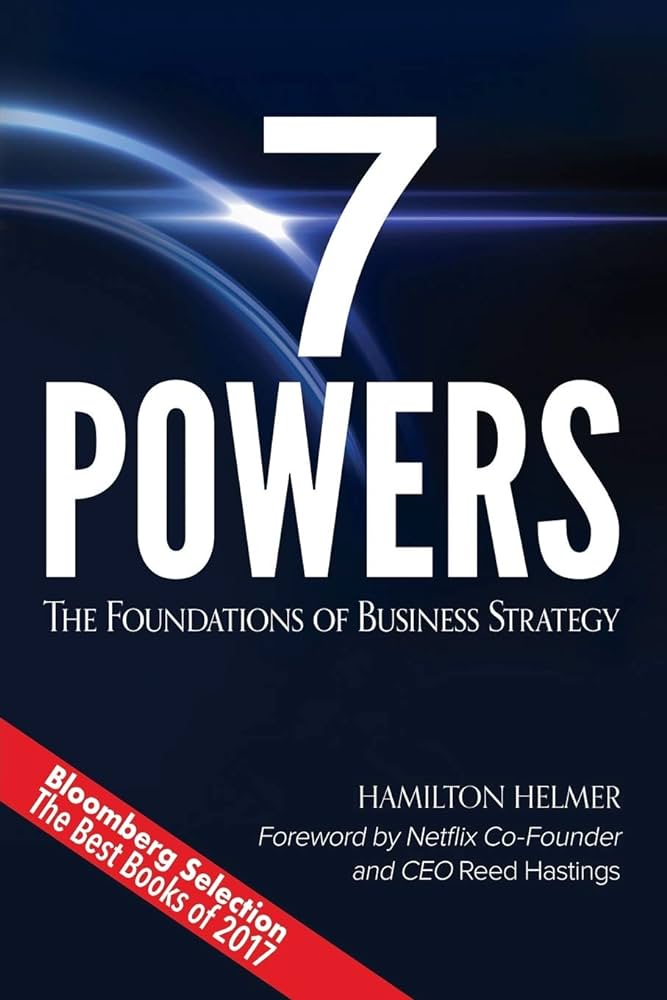Book review of 7 Powers by Hamilton Helmer

Overview
“7 Powers: The Foundations of Business Strategy” is a compelling exploration of the dynamics that dictate competitive advantage in the business world. Written by strategy expert Hamilton Helmer, this book distills the essence of successful business strategies into seven distinct powers that can lead to sustained profitability and market leadership. Helmer combines rigorous analysis with practical insights, drawing on his extensive experience and a wide range of case studies. The book is an essential read for anyone looking to deepen their understanding of what drives lasting success in business.
Seven Powers
The core of Helmer’s thesis is that enduringly successful businesses are those that can harness and maintain one or more of these seven powers. Below is a table summarizing each power, along with an example to illustrate its application in the real world.
| Power | Definition | Real-World Example |
|---|---|---|
| Scale Economies | Achieving cost advantages through expanded production. | Walmart leverages its vast distribution network to offer lower prices than competitors. |
| Network Economies | Value increases for all users as the network expands. | Facebook has become more valuable as more people have joined the network. |
| Counter-Positioning | A newcomer adopts a new, superior business model that the incumbent cannot mimic without impairing their existing business. | Netflix disrupted Blockbuster with its online streaming service, a move Blockbuster couldn’t replicate without jeopardizing its DVD rental business. |
| Switching Costs | Costs that make customers reluctant to switch to another product or service. | Adobe’s Creative Cloud creates high switching costs through its suite of integrated design tools, making it costly for users to switch to competing products. |
| Branding | Establishing a trusted identity that distinguishes the product in the marketplace. | Apple has built a powerful brand around design and innovation, allowing it to command premium prices. |
| Cornered Resource | Exclusive control over a crucial resource. | Google’s control over search algorithms and data makes it nearly impossible for competitors to match its search capabilities. |
| Process Power | Superior operations and execution that competitors cannot replicate. | Toyota is renowned for its efficient manufacturing processes (The Toyota Production System), which have set the standard for the automotive industry. |
Dynamics - Value and Timing
Market Value Implications
The seven powers outlined by Hamilton Helmer not only serve as a foundation for building a competitive advantage but also play a crucial role in enhancing and sustaining a company’s market value. Each power contributes to market value in unique ways:
| Power | Market Value Contribution |
|---|---|
| Scale Economies | Companies that achieve scale economies benefit from lower cost structures, which can lead to higher profit margins and greater financial flexibility. This efficiency often translates into a stronger market position and higher market value, as investors value the durability of these advantages. |
| Network Economies | Firms with strong network economies can experience exponential growth in user base and revenue, significantly enhancing market value. As the network becomes more valuable with each additional user, these companies can command premium valuations based on their growth potential and barriers to entry they create. |
| Counter-Positioning | Counter-positioning can lead to rapid market share gains and the disruption of established markets. Companies that successfully counter-position can achieve high valuations as markets anticipate the future profits that these innovative business models can generate. |
| Switching Costs | High switching costs lock in customers and create predictable, recurring revenue streams. This reliability of earnings is highly valued by the market, often leading to higher valuations for companies that can effectively create and maintain these barriers. |
| Branding | Strong brands can command premium prices and customer loyalty, leading to higher profit margins and more stable cash flows. Companies with powerful brands often enjoy higher valuations due to their perceived lower risk and strong customer relationships. |
| Cornered Resource | Exclusive control over a crucial resource can provide a company with unmatched competitive advantages, leading to monopoly-like profits. The market typically assigns high valuations to these companies due to their unique position and the difficulty competitors face in replicating their success. |
| Process Power | Superior processes and execution that lead to unmatched efficiency and quality can create a sustainable competitive advantage. Companies known for their operational excellence often receive higher market valuations, reflecting the market’s expectation of continued leadership and profitability. |
Incorporating the seven powers into strategic planning not only fosters a sustainable competitive advantage but also signals to investors a company’s long-term value creation potential. Strategists and executives must therefore consider how to leverage these powers not just for operational success, but as a means to enhance perception and reality of market value. This strategic alignment with the seven powers can attract investment, support higher valuations, and provide a foundation for sustained financial performance.
Timing: Establishing the Powers
Understanding when and how each of the seven powers is established is crucial for strategists seeking to build and sustain competitive advantage. Here’s an overview of the dynamics behind the establishment of each power:
| Power | Establishment Dynamics |
|---|---|
| Scale Economies | Scale Economies are typically established during a company’s growth phase, where efficiencies are gained through larger production volumes. This power solidifies as the company optimizes its production and distribution, achieving lower per-unit costs than its competitors. |
| Network Economies | Network Economies emerge as the network grows and becomes more valuable to its users. The key moment is reaching a critical mass of users that triggers a self-reinforcing cycle of growth, making the network increasingly indispensable. |
| Counter-Positioning | This power is established when a new entrant innovates with a business model that incumbents cannot replicate without compromising their existing operations. The establishment phase often involves the entrant proving the viability of its model, at which point it becomes a significant barrier to the incumbent’s ability to respond. |
| Switching Costs | Switching costs are built up over time as customers become more entrenched in using a product or service. This power solidifies as it becomes increasingly inconvenient or costly for customers to switch to a competitor, often through the accumulation of data, customization, or integration with other tools and services. |
| Branding | Branding power is established through consistent delivery of a differentiated value proposition, coupled with effective marketing and customer experience. This power becomes entrenched as the brand becomes synonymous with a particular quality, reliability, or status in the minds of consumers. |
| Cornered Resource | A cornered resource is secured either through strategic acquisition, exclusive agreements, or through the development of proprietary technologies or processes. This power is established when a company gains control over a resource that competitors cannot easily duplicate or substitute. |
| Process Power | Process Power is established through continuous improvement and innovation in operations. This is often the result of a long-term commitment to operational excellence and can be solidified as the company sets industry standards that others find difficult to match. |
For businesses, recognizing the phase in which a power can be established is critical for timing strategic initiatives and investments. Whether it’s scaling operations, growing a user base, innovating a business model, developing a brand, securing resources, or refining processes, understanding these dynamics helps leaders make informed decisions that align with the long-term strategic goals of establishing and maintaining competitive advantage.
Analysis and Evaluation - Power of OpenAI

| Power | Application to OpenAI | Benefits | Barriers | Value and Timing |
|---|---|---|---|---|
| Scale Economies | Investments in large-scale AI models like the GPT series. | Efficiency in AI development; leadership in innovation. | High costs of computing resources and data acquisition. | Early investments in scale solidify leadership; ongoing effort required. |
| Network Economies | Indirect network effects through widespread adoption of OpenAI technology. | Increased adoption and value of OpenAI’s ecosystem. | Ensuring reliability and ethical use across applications. | Continuous improvement to sustain indirect network benefits. |
| Counter-Positioning | Open-source approach and focus on AI safety and ethics. | Market differentiation; trust from community and partners. | Balancing openness with monetization needs. | Timely emphasis on safety and ethics in response to regulatory concerns. |
| Switching Costs | Integrations of OpenAI’s APIs create barriers to switching. | Customer retention; predictable revenue from API usage. | Maintaining API superiority to prevent users from switching. | Enhance API offerings to increase switching costs. |
| Branding | Strong brand associated with cutting-edge research and ethical AI development. | Attraction of talent and partnerships; user trust. | Managing public expectations and ethical scrutiny. | Continuous commitment to ethical AI and transparency. |
| Cornered Resource | Access to unique datasets and proprietary AI models. | Unique AI model training and deployment capabilities. | Competition for data resources; legal and ethical considerations. | Early development of proprietary models and datasets is key. |
| Process Power | Rapid innovation and collaboration in R&D processes. | Speed and quality of innovation; setting AI development standards. | Scaling processes while maintaining innovation quality. | Ongoing refinement and adaptation to new challenges. |
OpenAI’s alignment with the 7 Powers framework underscores its robust strategic positioning in the AI landscape. The company’s focus on scale, innovation, ethical standards, and proprietary resources sets a foundation for sustained competitive advantage. Strategic investments in these areas, coupled with agile response to external challenges and opportunities, are essential for maintaining leadership and maximizing market value in the fast-evolving AI sector.
Conclusion
In “7 Powers,” Hamilton Helmer provides a clear and actionable framework for understanding and applying the principles of strategic power. The book offers valuable insights for business leaders and strategists looking to build and sustain competitive advantage. By examining real-world examples of each power, Helmer not only theorizes about these concepts but also demonstrates their application in the business world, making it a must-read for anyone involved in business strategy.